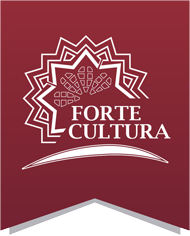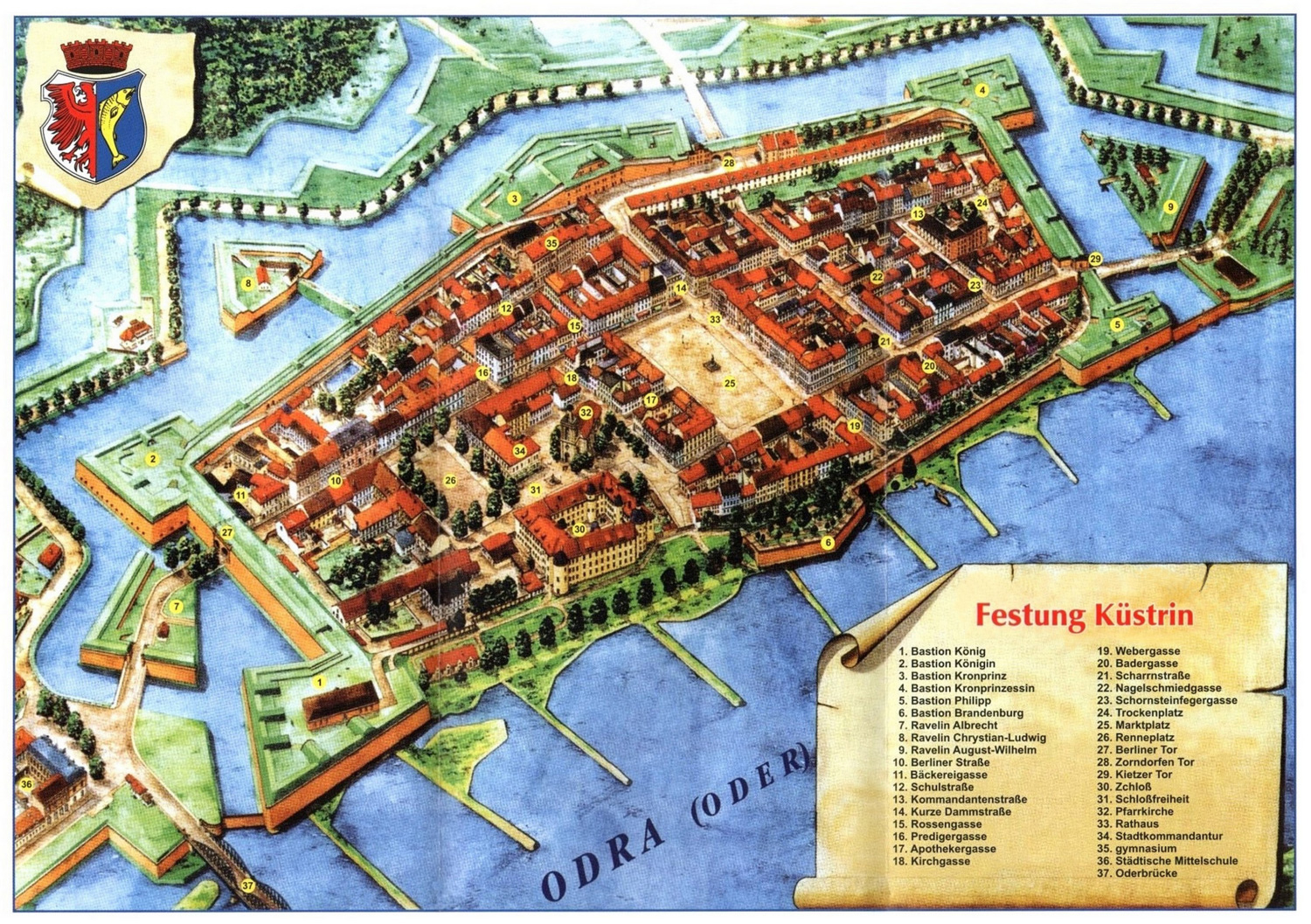Fortress Küstrin in today’s Kostrzyn (PL) is a special place on the meeting point of Odra and Warthe. At the end of World War II, the whole old city was completely destroyed during severe battles and was never rebuilt.
But parts of the fortress, like bastion Philipp, the Berlin gate or the Kietzer gate were lovingly restored and are a strong contrast to the ruins of the old city. With a flora and bird life developed of centuries it is a unique atmosphere – the “Kostrzyn Pompeii”.
Discover the time when Kostrzyn was one of the most beautiful cities of Brandenburg on a guided walk. Or take part in festivals like „Fortress Kostrzyn Days“ or the “Woodstock Festival Poland”, which attract hundred thousand visitors each year.
Experience World
Bastion Philipp and Kietzer gate
When marching from the East to fortress Kostrzyn you are welcomed on the left of the Kietzer gate the majestic bastion Philipp.
It is one of three preserved bastions of the fortress and opened for visitors since May 2014. The casemates accommodate an interesting permanent multimedia exhibition about the most important history of the city, Garnison and fortress Kostrzyn. Especially the destroying battles from February and March 1945 are well presented.
With other interesting exhibits the catastrophe of the Seven Years’ War, the destruction of the city on the day before the battle of Zorndorf on 25th August 1758 and the history of the Kostrzyn castle as “nest of Hohenzollern” are looked at.
Also the stages of the building and modernisation of fortress Kostrzyn can be interactively seen in the museum in the bastion Philipp.
Berlin Gate
The Berlin gate is one of three gates that offered admission to fortress Kostrzyn. In the restored rooms chosen exhibits found on the area of the old city can be seen.
Some of the most interesting objects are: The coffin lid of the coffin of Katharina von Braunschweig (a reconstruction from 1882), an exhumation coffin from 1713 and different findings from the Bronze Age (jewellery, clothing needles, urn, etc.).
Also the tourist information and the museum shop are located in the Berlin Gate. Many souvenirs, a lot of information material and literature about Kostrzyns history can be bought. The Berlin gate is closed from October to March.
Fort Gorgast is an outer fort of fortress Kostrzyn and is located in the south-west, on the outskirts, across the Orda in the Germany village Gorgast.
The impressive defence facility built in 1883-89 is surrounded by a moat and offers an impressive architecture with vaults, gunpowder chamber, gatehouse and wall facilities.
Tourists can use the diverse leisure and relaxation offers in the mostly natural facility and visit interesting exhibitions and events in the military historic scenery. The fort can be rented temporarily.
This fort was also built as an outer fort north of the fortress Kostrzyn from 1838 and belongs to the most impressive works of its time. It is located in the polish village Sarbinowo.
Fort Zorndorf is different from the other fortresses built in series, especially with its unusual inner structure. Regarding this is it’s a unique appearance in German fortification architecture together with Fort Gorgast which was built also in Kostrzyn and at the same time. The garrison could contain of up to 600 people together with artillery soldiers, a pioneer crew, telegraph crew, officials and officers.
The fort is currently in a very bad shape and unsecured. The entrance if offically forbidden and very dangerous.
Forts Säpzig and Tschernow (Czernow)
The outer forts Säpzig (built 1887-90) and Tschernow (built 1888-90) are located in the east of fortress Kostrzyn in the villages Zabice und Czernow.
When the state of the fortress changed in 1886, it was decided to reduce the equipment of both forts to a minimum. Therefore, they did not have any barracks for the crew, which were not added until 1914. The original designed batteries for 12 wall pieces each and 4 mortars were back then already only infantry works – in the ramparts protecting the gun emplacements the trenches were excavated.
Tour Offers and Information
Museum Fortress Küstrin
The Museum of Fortress Küstrin can be found on the Polish side, on the right in the former border station, directly behind the Oder bridge. Here, in addition to the museum management, there is a modern conference hall and a small fortress library with a reading room.
In the casemates of the Bastion Philipp is a thrilling permanent exhibition and the Berlin Gate also offers visitors some interesting exhibits. Guided tours of the old town complete the museum offer.
City of Kostrzyn nad Odra
The city of Kostrzyn nad Odra is nestled in a beautiful natural landscape. Many tours, itineraries and educational trails allow guests to experience this offer. Whether guided tours of the old town, water walks or bike rides, the natural treasures of the Warta estuary in the Oder can be explored in many different ways.
Guided tours
The Tourist Information Kostrzyn nad Odrą Sp. Z o.o. offers in several languages also exciting thematic tours of the old town of Küstrin with its fortifications. But also events, tours, excursions, excursions and short trips with changing content in the German-Polish border area are offered. In addition, the site informs about the history of Kostrzyn and current topics.
Map
Monument and History
History Kostrzyn was first mentioned in 1232 and city rights by margrave Albrecht von Brandenburg III. In 1300. From 1535-1571 the city was home of Johann von Brandenburg-Küstrin and the capitol of the region Neumark. The castle and the fortress were built at the same time.
On 6th November 1730 the Prussian King Frederic William I. had the friend of his son Frederic II, Hans Hermann von Katte beheaded in this fortress because of desertion. Before he supported his friend at a failed attempt to escape. He had to watch his execution from his cell.
In 1806 Napoleonic troops occupied the fortress until they were exiled by Russian and Prussian troops in 1814.
The blossom time of Kostrzyn was from 1857 because of the connection to the Prussian railway system from Berlin to Frankfurt (Oder). The transportation hub between street, rail and waterways stimulated the economy and the fortress was constantly further developed and extended with outer forts.
During World War II almost 95% of the buildings of the city were destroyed. Kostrzyn was taken over by the Red Army on 11th March 1945 and was given to Polish administration after the war. After the war he remaining parts of the old city within the fortress walls were levelled to the ground. These bricks were partly used to rebuild other Polish city as for example Warsaw.
Architecture After the completion in 1590 the fortress was one of the biggest buildings of the fortification architecture in modern Europe. Six bastions border the monument: “King”, “Queen”, “Princess”, “Philipp”, “Prince” and “Brandenburg”.
After 1860 lunettes and guard rooms were added to the defence architecture to control streets, waterways and the newly developed railways.
Virtual 3D Model of the Old-Town Küstrin
Nature The fortress Kostrzyn is a mighty bulwark directly at the Odra. From the fortress wall you will have a fantastic view over the river and the Odra island on the other side. In the oldy city ruins that were mostly untouched, a wild flora and bird life has developed which can now be seen on guided walks.
Partner


